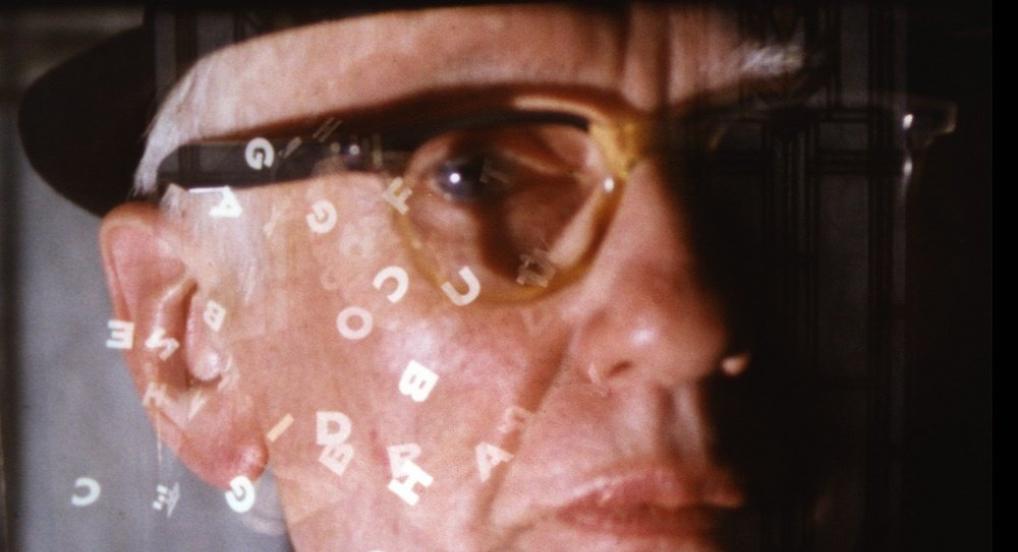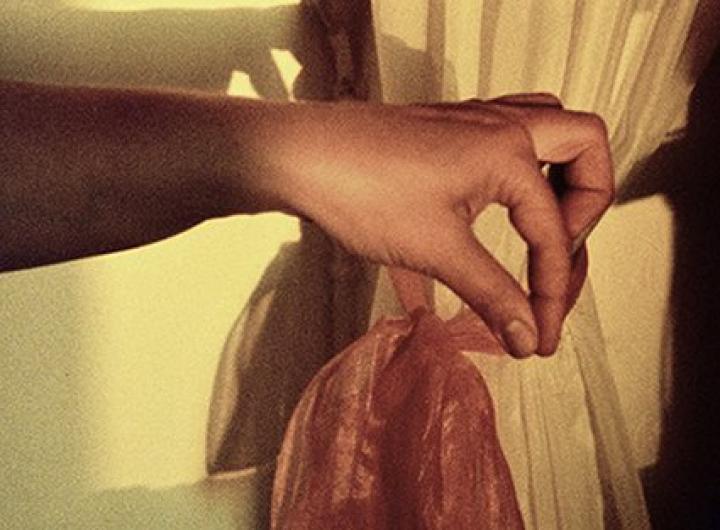Through A Lens Brightly: Mark Turbyfill by Gregory J. Markopoulos
15 min, 16mm, color 1966
The Sparrow Dream by Robert Beavers
29 min, 16mm, color 2022
Kopfüber im Geäst by Ute Aurand
15 min, 16mm, color/b&w, silent 2009
Through a Lens Brightly: Mark Turbyfill was made in 1966 in Chicago. I met Turbyfill at dinner at Ruth Page’s. A plan was instigated that I prepare a film on Ruth and a separate film on Mark. Ruth’s film was never made. The film was made in four hours using Ektachrome Commercial 7255 and a Bolex Reflex Camera. Before my arrival at his home, Mark had arranged a selection of photographic, literary documentation for me. From these, without any previous preparation, any selection was made; we worked the same way as far as the very filming was concerned. Everything merged, became, during the four hours we worked.The editing, and filmic form was achieved in the camera itself. The sole freedom Mark had was in my accepting his suggestion to film him with the superimposed letters over his face (something which had great meaning for him) and wearing a costume he had prepared as a surprise for the filmmaker.
Turbyfill was Ruth Page’s famous dance partner; he won one of the early Oklahoma auto races; he is a poet and a painter also. He was the first recipient of the Poetry magazine award. The founders of Poetry magazine, Margaret Anderson and Harriet Monroe, were/are close friends; all these people were part of the most important Chicago School, with its fabulous international connections/ activities. All these people appear in the film, of course. As far as I know it is the only documentation of its kind. What it does to the film spectator is not so much to tell him who is this and who is that, but rather, because of the shortness or longness of the images, to reveal in after images what the film is about. An emotional illusion is created towards everyone’s search for the True Reality. I say True Reality, for I have always felt very strongly that there is a very, very great element of “eternity” in each bit of film. The secret is absolutely there; especially in the use of the single frame, and of slow motion. I am convinced that, when aborigines talk of being photographed and fear the image captured, it is this awesome idea of “eternity.” But I have gone far afield from Through a Lens Brightly: Mark Turbyfill.
Gregory Markopoulos 1st of November, 1971 Amsterdam
…
Sleep, thought, memory.” Beavers’s voice repeats these words like an incantation in his newest work, The Sparrow Dream (2022). They could describe any of his films. How is sleep like thought like memory? The answer is in the interplay between lush sensation, on one hand, and the processes of language, patterning, and abstraction on the other. This is a cinema of the mind entangled with the world. What we see is a highly complex choreography of fragmentary sounds and views, multiplied, and repeated, sometimes across films, sometimes over decades. The stout red comb of a ceramic rooster, for example, catches the eye (it is perhaps the closest thing to a scene-stealer in all of Beavers’s films) in several shots of Pitcher of Colored Light, then returns, fifteen years later, in The Sparrow Dream. This is not really a coincidence—The Sparrow Dream is explicitly about returning to various homes, including that of Beavers’s mother in Falmouth, Massachusetts—but still it registers as a surprise.
…As rooms, his films are antechambers to the scenes of history, places where memory reconfigures the past in the present. In The Sparrow Dream, he returns to places where he previously lived in Germany and Massachusetts. He films a Prussian monument in Berlin, pages from his children’s edition of the Odyssey, his partner and filmmaker Ute Aurand, her silhouette elongated along a gravel road. “In one place, speaking of another. In one time, speaking of another,” he muses in voiceover. “What holds it all together?”
There, again, is that same questioning. Observing the chasm between places and times that span his entire life, he remains open to what might be resolved at a later point, or what might yet be revealed. In this Beavers has always been singular, even among his avant-garde contemporaries. He seems to see farther than anyone else. His films are imbued with incomparable patience, and with it, the wisdom to wait and watch.
Genevieve Yue, Notebook- Mubi, March 2023
…
There is of course a contradiction between the “now” of living and the time that it takes to make a film. Whereas the act of filming, especially in diary film, shares the present tense of the filmmaker’s existence, the task of editing, a much lengthier and time-consuming process, accentuates the distance between making a film and the lived experience that is at its origin. It is through rhythm that Aurand replicates the sense of lived moments in her films and attempts to preserve the personalities of the places and people that are recorded, as well as that of the filmmaker behind the camera. There is the rhythm of editing, but also that of her hand-held camera. Constantly moving while filming, for Aurand the notion of rhythm is essential: “You can call it ‘music’, but for me it is rhythm. Rhythm is energy and movement, rhythm creates space in my films.” Maria Palacios Cruz October 2014, Ghent/Brussels
" (...) regarding Aurand’s film, it is almost difficult to take in so much grace and gentleness in such concentrated form. Kopfüber im Geäst is an intimist portrait of sorts of her parents that revolves around the passing of time, of their becoming old and their eventual absence. It is a film that holds on, that clings to the most fleeting of moments; yet it is precisely this fleetingness, or the impossibility to hold on to and store them, that is celebrated; what is seized is already gone while being seized; an eternal present, but one brimming over with absence. The eventual absence of the parents also appears to imbue everything with an excess of meaning: memories, places (a room, a cabinet, a shattered wall), bushes, snow, shadows; an absence felt, mourned over, yet accepted, come to terms with; embraced, maybe; and all that is contained within the world of the film appears to bear witness to it. Voiceless, soundless, that hydrangea is curling in the wind, that snow is falling down; Yes, they seem to exclaim, to cry out, we witnessed their passing, and we mourn with you, yet we must remain unfazed; we cannot give in – (…) Simon Wiener, Jugend ohne Film, 2021







